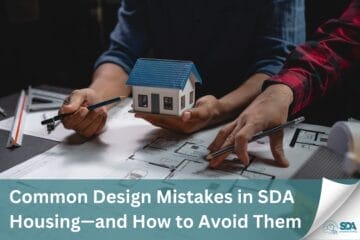
The Four Categories of SDA Design: Which One Will Suit Your Requirements the Most?
Starting the SDA design process can feel overwhelming. However, once an individual learns about the four basic categories, namely, improved liveability, robustness, full accessibility, and high physical support, it can make a world of difference. These SDA design options are aimed at meeting the needs of people with disabilities, enabling them to carry out their daily activities comfortably and safely. If you are wondering what is the best SDA design that would suit you or your family then this blog is the perfect read for you.
What is SDA Design?
SDA, or Specialist Disability Accommodation, encompasses architectural modifications that can be built specifically for individuals with considerable functional limitations or those who require extensive support. According to the NDIS’s design philosophy, those suffering from disabilities should be capable of living independently in the community as far as practicable and enjoying an enhanced quality of life.
The Four Categories of SDA Design Explained
- Improved Liveability
Improved Liveability homes have been primarily designed to increase the quality of life of persons with sensory, intellectual, or cognitive impairment. As the name suggests, these homes are developed with ease of use and accessibility of fitting and layout; however, different colors are used to improve vision enhancement, and layout designs help modify or eliminate ambiguities. Improved liveability housing is more about the design factors that promote safety, practicality, and comfort around the house.
Key Features:
- Use of color coding for efficient directions
- Better illumination and support features to help comprehend the design
- Spaces that can be adjusted according to different requirements
- Robust Housing
The robust design aims to ensure safety and damage avoidance for people needing a strong living space. This type is meant for those with a likely complex behavioral pattern, where strong materials and features that will minimize the risk of harm to residents and staff are required.
Key Features:
- Heavy-duty solid walls and structures that are hard to damage
- High-impact strength glass and strong surface finishes
- Secure places to calm a person or prevent harm from oneself or others
- Completely Accessible Design
For those who rely on wheelchairs or similar devices, SDA houses are completely accessible and space-efficient. These homes provide perceptual access as there are no environmental constraints so residents can move freely and independently within their homes. From spacious doorways to storage and appliances that are easy to grasp, these homes make daily chores quick and effortless.
Key Features:
- Easy access, no step thresholds, and increased width of entrance
- Bathroom facilities with grab rails, roll-in showers, and low-curtain baths
- Kitchens designed for easy access and use from a seated position
- High Physical Support Design
High physical support homes cater to people with the most significant physical needs, requiring a high level of assistance. Such houses include fully accessible design features but other additional aspects include slings, emergency call systems, and more.
Key Features:
- Ceiling hoists in bedrooms and bathrooms
- High-tech communication systems for support staff in a call
- Automated Features such as lights, blinds, and temperature of a particular area.
Choosing the Right SDA House Design
Selecting the right SDA design depends on the specific needs of the individual. Participants can work with qualified experts, such as SDA providers or housing specialists, who assess their requirements and recommend designs that balance independence with necessary care support. These tailored recommendations ensure the home is suitable for the participant’s lifestyle and support needs.
The Importance of Customization
Every SDA design category is customizable to suit the individual’s lifestyle and other preferences. Knowing these categories empowers NDIS participants and their families to take advantage of the opportunities to make the right choices on how their housing will be structured to enhance autonomy and comfort.
Call to Action: Take the Next Step in Your SDA Journey.
Are you searching for the ideal SDA design that perfectly meets the needs of you or your loved one? You can speak to our team for a more focused approach. The right living environment can transform everyday life, promoting independence and well-being. Take the next step today and make your SDA design choice with confidence!








